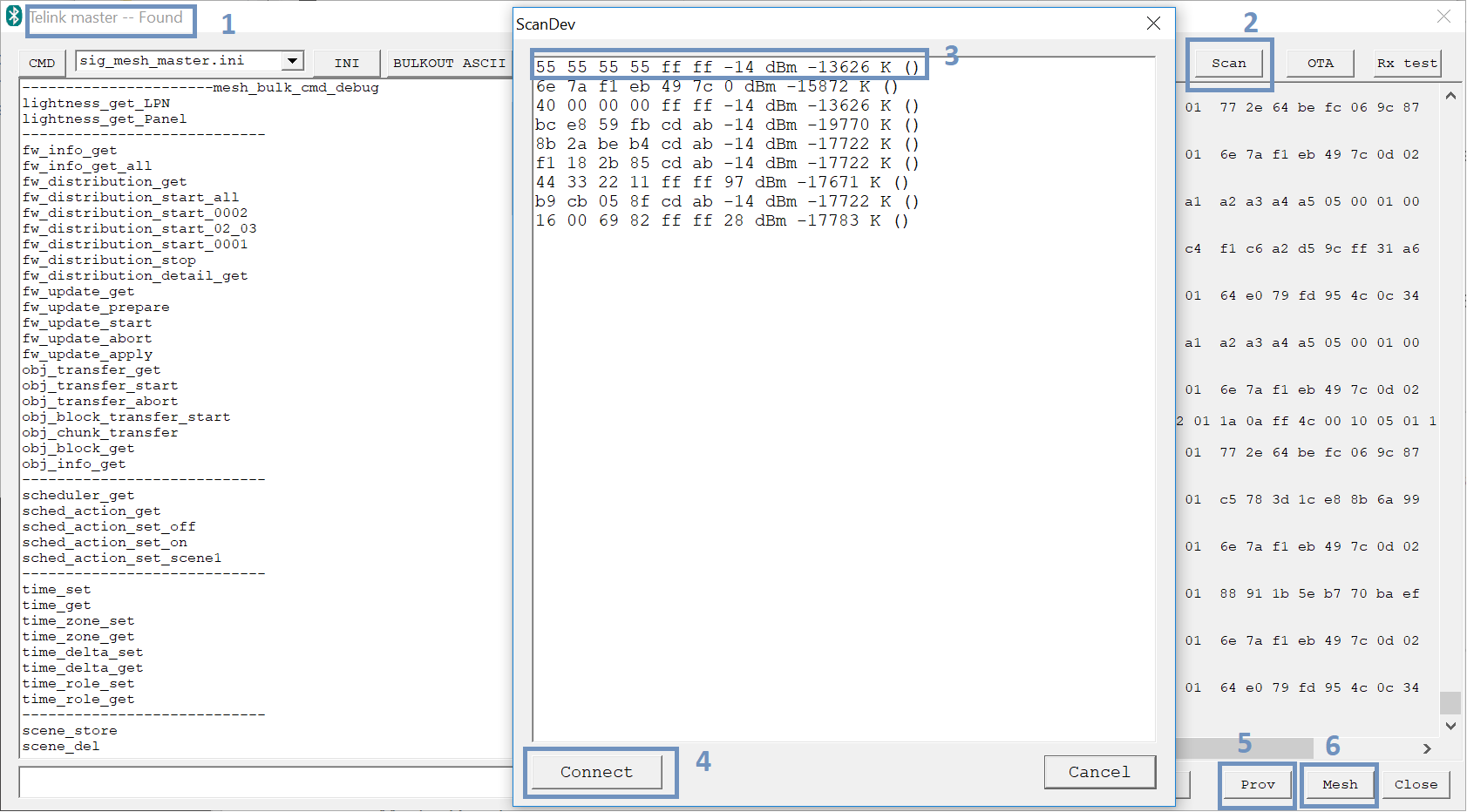Bluetooth® Mesh Solution
Conetents
Introduction
Bluetooth Mesh combines the benefits of mesh networks with Bluetooth’s massive installed user base. Telink has paired powerful hardware with an industry-leading protocol stack to put true Bluetooth Mesh connectivity into the hands of some of the world’s largest device-makers, and all Telink’s Bluetooth Mesh SoCs are certified by the Bluetooth SIG.
Telink TLSR825x, TLSR827x, and TLSR921x series SoC support the access of Baidu Xiaodu, Tmall Genie, Tuya Smart, Xiaomi Mijia platforms, etc. The typical applications include dimmable lamps, color temperature lamps (CT lamps), RGB lamps, and other low-power devices. Users can control and query the device’s status by the speakers and APPs of the corresponding platforms.
Resources
Developers can click the “Dev Kit” in the below table to get started with the demonstration
| Part Number | Datasheet | SDK | Dev Kit | Hardware Design Guide | Reference Design |
|---|---|---|---|---|---|
| TLSR8258F1KET32 | TLSR8258 Datasheet | SIG Mesh Tc32 Platform | B85 Mesh Starter Kit | B85 Hardware Design Guide | TLSR8258 Dongle TLSR8258 Mesh RCU |
| TLSR8258F512AT32 | TLSR8258 Datasheet | SIG Mesh Tc32 Platform | B85 Mesh Starter Kit | B85 Hardware Design Guide | TLSR8258 Dongle TLSR8258 Mesh RCU |
| TLSR8253F512ET32/AT32 | TLSR8253 Datasheet | SIG Mesh Tc32 Platform | B85 Mesh Starter Kit | B85 Hardware Design Guide | TLSR8258 Dongle TLSR8258 Mesh RCU |
| TLSR8278F1KET48 | TLSR8278 Datasheet | SIG Mesh Tc32 Platform | B87 Generic Starter Kit | B87 Hardware Design Guide | TLSR8278 Dongle |
| TLSR8273F512ET48 | TLSR8273 Datasheet | SIG Mesh Tc32 Platform | B87 Generic Starter Kit | B87 Hardware Design Guide | TLSR8278 Dongle |
| TLSR921x | TLSR9218 Datasheet | SIG Mesh RISC-V Platform | B91 Generic Starter Kit | B91 Hardware Design Guideline | B91 Development Board B91 Dongle |
- Telink provides the Sig Mesh SDK for TLSR8 series SoC and the B91 Sig Mesh SDK for TLSR9 series SoC to compatible with different ecosystem platforms. If you need to access Tuya Smart, Xiaomi Mijia platforms, Please contact Telink Sales Team for more details.
Bluetooth® Mesh Demo
Material List
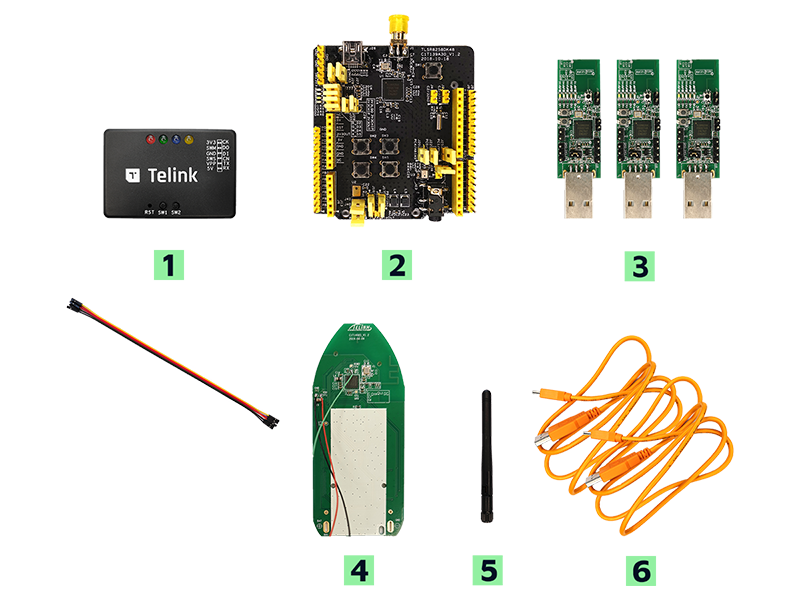
| Item | S/N | Product Name | Qty |
|---|---|---|---|
| 1 | TLSRGSOCBK56B | Telink Burning Board (SWS BURING EVK, including DuPont wires) | 1 |
| 2 | TLSR8258DK48D | TLSR8258 Development Board | 1 |
| 3 | TLSR8258DG48D | TLSR8258 Dongle | 3 |
| 4 | TLSR8258MRC32D | TLSR8258 Mesh RCU | 1 |
| 5 | Whip antenna | 2.4Ghz antenna | 1 |
| 6 | USB cable | USB A to mini USB | 2 |
The B85 Mesh Starter Kit includes:
- Multiple USB dongles for simulating mesh nodes or gateways
- Remote control PCBA for simulating remote controller, wall switch, and also for demonstrating group controls
- Telink Burning Board
PC installed with
- TELINK BDT tool
- SIG Mesh Tool for controlling mesh nodes (included in the SIG Mesh SDK.zip, \tools)
Mobile installed with
- Reference Android or iOS APPs (included in the SIG Mesh SDK.zip, \app)
Features
Bluetooth® Mesh demo is presented in 4 different ways:
- Node Control by APP with OTA
- Node Control by Gateway with OTA
- Node Control by Remote
- Node Control by Master Dongle with OTA
Quick Start
Configuring the Starter Kit
You can use the prebuilt binary for the following demo testing - Demo binary based on SDK
- 82xx_mesh.bin - the mesh light node
- 82xx_mesh_gw.bin - the mesh gateway with PB_ADV capability
- 82xx_mesh_LPN.bin - the mesh low power node
- 82xx_mesh_switch.bin - the mesh light switch node
- 8269_mesh_master_dongle.bin - the mesh master dongle with PB_GATT
For further info, please refer to the Developer Handbook for Telink Bluetooth Mesh SDK.
Node Control by APP
Node control by gateway demo requires 2 pieces of dongle simulating light bulb. They can be either 8258 or 8269. 8258 is used in this example. Light bulb bin is generated by “mesh” project with “8258_mesh” compile option. Available projects in SIG mesh SDK is shown below. The light bulbs, if has been provisioned previously, need to reset by having 3 short power cycling (on/off each 1s) followed by 2 long power cycling (on/off each 3-5s).

Launch “TelinkSigMesh” APP under either Android or IOS. On front page as shown below, click “+” on upper right corner to add device. In “Device Scan” page, scan and wait each node from “binding” to “bound”.
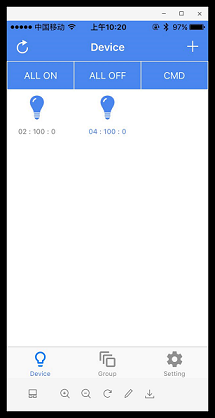
Back to front page, tap on light icon would toggle on/off, long press would enter into “Device Setting” page as shown below. LUM and TEMP level and group assignment can be set in “Control” and “Group” tab, respectively.
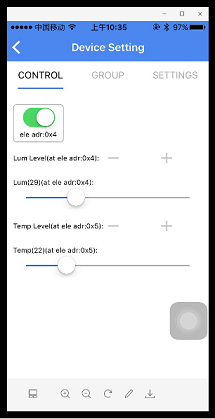
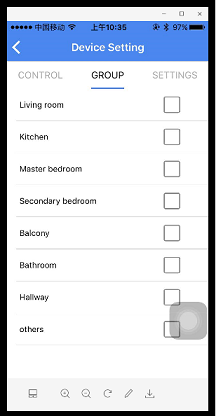
In “SETTINGS” tab as shown below, schedule, subscription, publish model can be set. Device OTA is also enabled. For schedule, macro “MD_TIME_EN” in mesh_config.h under vendor/common/ dir in SDK. Last, “KICK OUT” tab at the bottom would remove the light bulb from network.
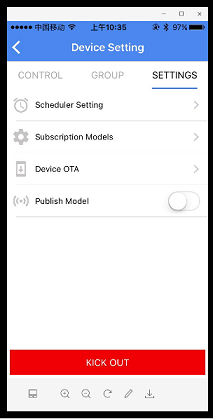
Node Control by Gateway
Node control by gateway demo requires 3 pieces of HW as shown below: 2 pieces of light bulb and 1 piece of gateway dongle. In this example, light bulb uses 8258 while gateway dongle is 8258.
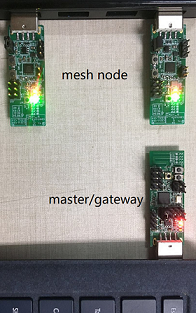
8258 dongle in this example is programmed by using “mesh_provision” project in SDK and “8258_mesh_gw(provisioner)” compile option; and light bulb bin is generated by “mesh” project with “8258_mesh” compile option. After being programmed, gateway dongle must be plugged in USB port of PC and light bulbs can be powered by any USB port.
In “sig_mesh_tool”, INI file needs to switch to “tl_node_gateway.ini” in pull down menu as shown below. The light bulbs, if has been provisioned previously, need to reset by having 3 short power cycling (on/off each 1s) followed by 2 long power cycling (on/off each 3-5s). Successful reset would trigger 3 blinks.
Next step is to launch “sig_mesh_tool” as shown below. Step 1 is to confirm gateway dongle is “Found”. Step 2 is to click on “Scan” button to pop out a window, select the MAC Address of the light bulb as Step 3 and then select “connect” as Step 4. Then click on “Prov” as Step 5. MAC address can be customized using BDT tool.
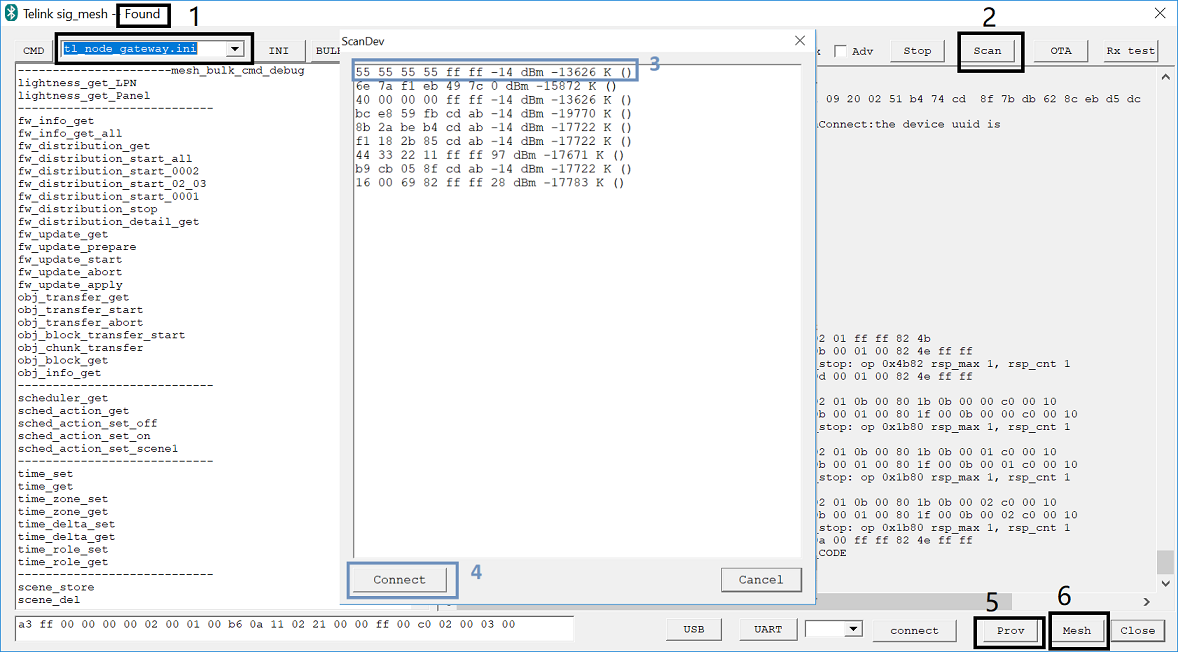
In Provision window as shown below, First click on “setPro_internal” (only once),then “Provision” button on left pane, once provision is finished, “bind_all” on right pane becomes selectable, go ahead select “bind_all” to complete provision. LED on light dongle should blink at provision completion. “Uncast_addr” is automatically incremented by “0x0200” as an unique ID to each light bulb. Repeat “Scan”, “Connect” and “Prov” for the other light bulb.
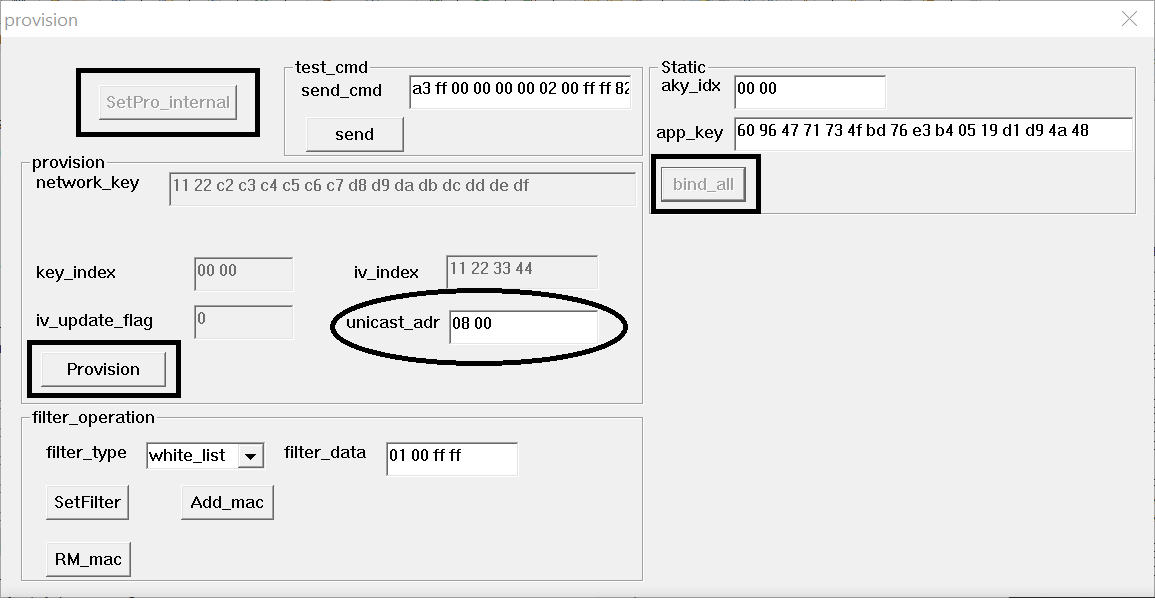
Now continue into Step 6 by clicking on “Mesh” button in “sig_mesh_tool” UI. This will bring out the light control UI as shown below. Light bulbs is listed in the “Mesh” pane on left side of the window with corresponding unicast address. By double clicking on the specific light, as indicated in field “2”, this particular light can be assigned to desired group by checking on the open box as step “3”. Once group assignment is done, each group can be turned off/on by itself.
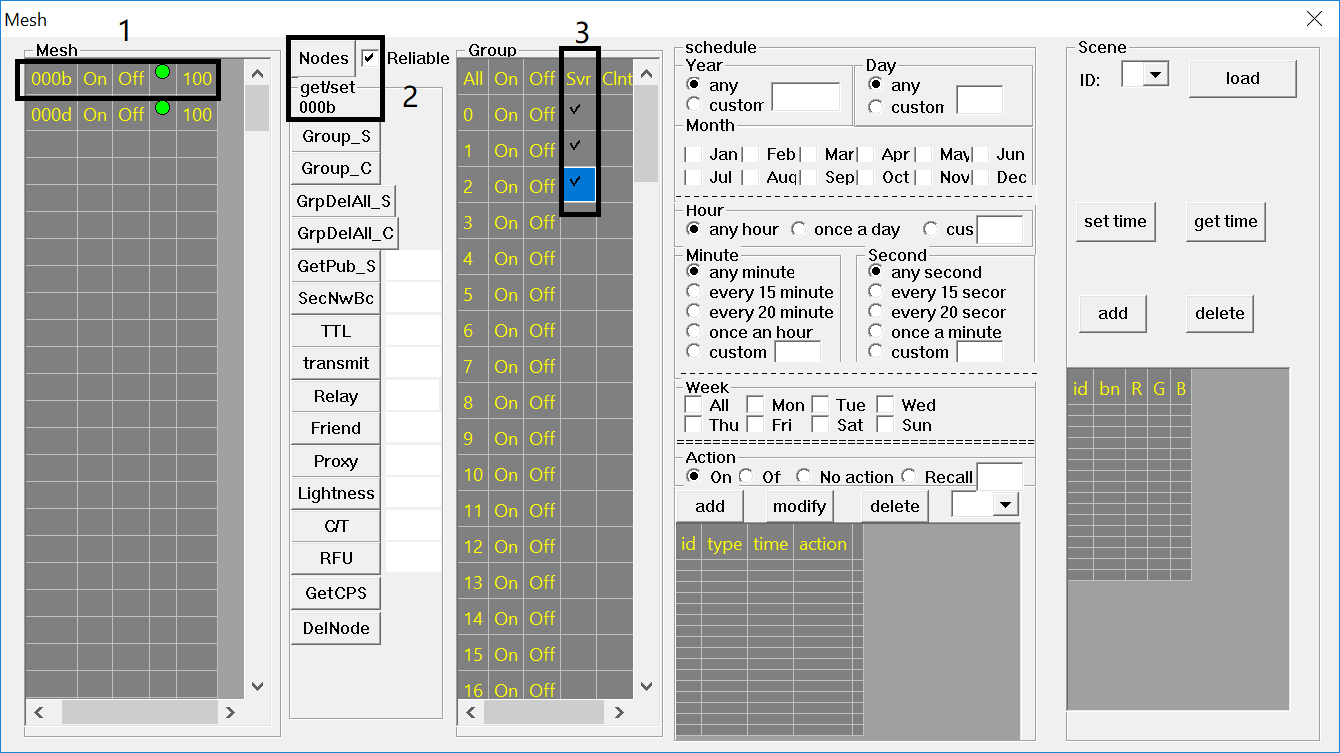
Node Control by Remote
Following is a lighting remote control HW, SOC can be either 8258 or 8269.
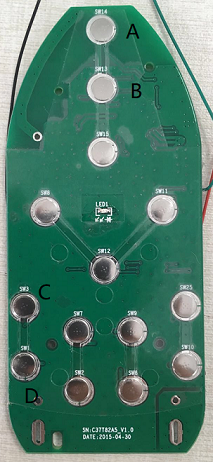
First, generate remote bin file by using “mesh_switch” project in SDK and using “8258_mesh_switch” compile option in this example. Please notice that a button need to be pressed while download FW. Once programmed, the remote control will need to go through the same “scan”, “connect” and “provision” procedure as described above for lighting bulbs. Afterwards, user can use button A and B as indicated to turn all on and all off, respectively, and they are SIG model commands. Press A and D simultaneously will put it in advertising mode, LED will also blink. C and D are to control group on/off, and they are vendor model command, for the time being, only internal printing message are available for C and D commands.
Node Control by Master Dongle
Master dongle demo shares same HW as gateway demo.
Master dongle bin is generated by “8269_mesh_master_dongle” project in SDK; and light bulb bin is generated by “8258_mesh” project with “8258 mesh” compile option. After being programmed, master dongle should plug in PC USB port.
In “sig_mesh_tool” as shown below, “sig_mesh_master.ini” is used. Provision and grouping in Mesh window is the same as gateway.
